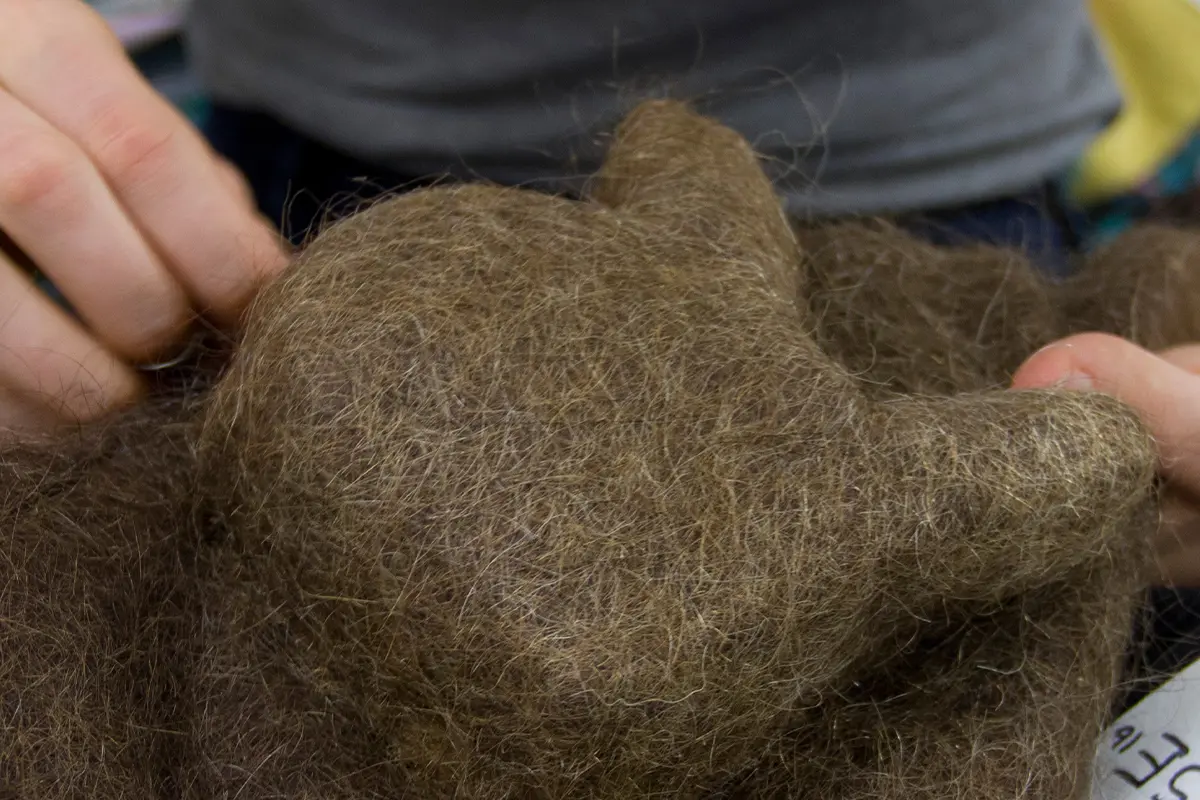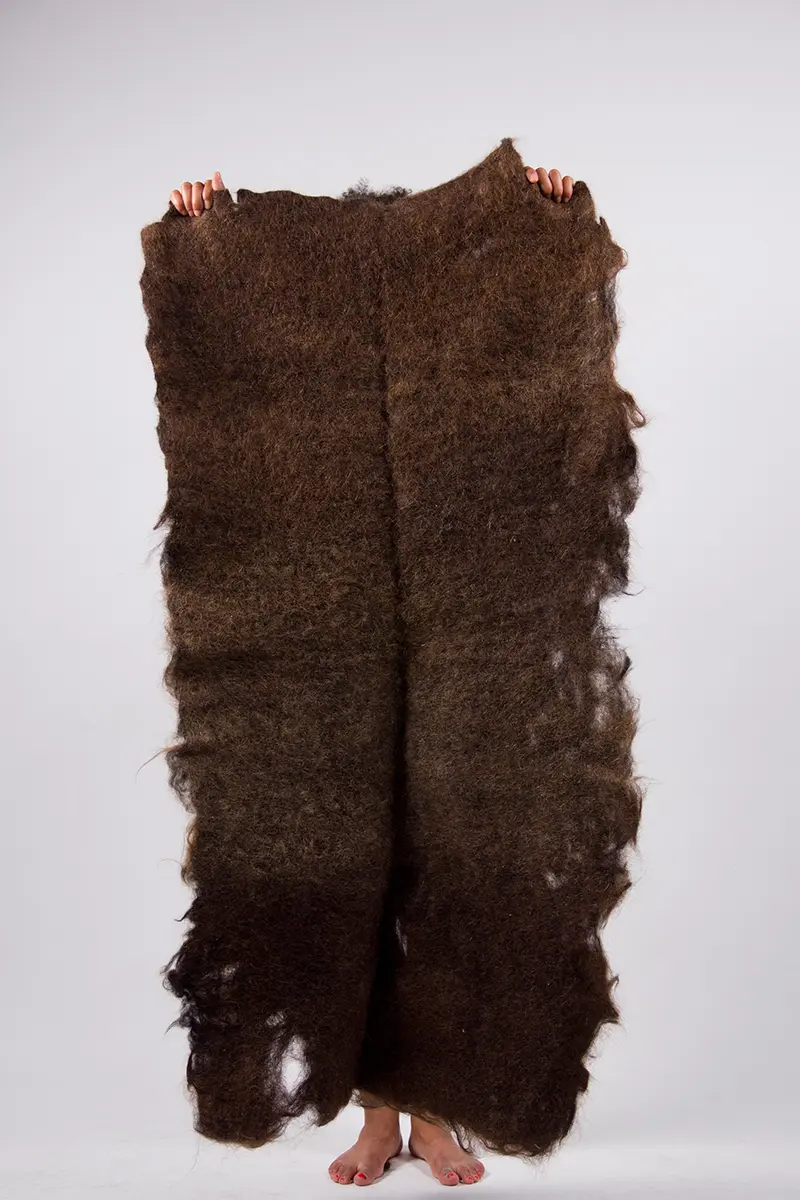The design industry could benefit from the use of natural fiber – but at what cost? Comparing hair and wool, raw materials whose characteristics are alike
Lampoon reporting: the rephrasing of human hair out of the bodily context
Hair has always been around as a material to work with. In Japanese culture, for instance, hair was and still is considered an important element in one’s overall look, as a means of telling one’s status and rank in society. The Higashi Hongan-Ji Temple in Kyoto prefecture, tells the unique story of the largest wooden structure in the world built with the contribution of ropes made out of hair cut from the female devotees strong enough to move around massive wooden beams.
When the time came, they all decided to cut off their long locks and braid them together to make a strong and thick rope, still today on display to be looked at into a glass container, resisting the passing of time. In Indonesia, people used to fish using nets made out of hair. So the material has always been around. Nowadays designers are coming out with the newest technique to work with hair when in reality it’s always been there. And it is evident in every culture around the world.
The Western-centric view has made hair progressively to become sacred and/or untouchable, making the separation between the sacrality of our body and nature very persistent. We consider ourselves almost outside of it.
Alix Bizet critical and analytical approach to design and material research
Lampoon spoke to UK-based Material Researcher, Designer and Educator Alix Bizet about her critical and analytical approach to design and material research.
«I didn’t invent anything. I basically reactivated a knowledge that was already there. Today, there is a need for new material. We’re going greener and we are returning to what our ancestors used to do».
Bizet explained that her fascination with hair derives from childhood, back to when the women of the family (her mother and sister) used to braid hers and each other’s hair.
Her ambition to work with it came back after graduating in Eindhoven, Netherlands, where she was asked to reflect about the surrounding landscape and the relationship of humans in nature. «I decided to focus on the fact that people define their identity through their hair. Making a garment with it uses the metaphor of a fiber that composes our personal garden».
Human hair vs. wool. A comparison
We take wool as a comparison to human hair. Throughout her investigation, Bizet came across a felter in Eindhoven who was using “unwanted wool”. Unwanted wool is a byproduct of the wool industry that gets discarded because it’s not soft or fluffy enough. The demand is only for fluffy and soft material that doesn’t have to be itchy in contact with the skin, so Merino wool became the number one wool. This way, the industry standardized wool making all the other types “unusual” only because they would require more work to be able to spun it.
In the same way, there’s a separation between wanted and unwanted hair, because of its diverse nature in length, texture and style. As it happens for wool, there’s one preferred type of hair, and it is straight and long. Bizet investigated the issue with the hairdressers and proceeded to work with the Eindhoven based felter to develop her material using hair not only as a fiber with unique strength and versatile features but also as a social and political remark.
From a technical point of view, wool contains a lot of lanolin and it has little hooks in its structure, going in every direction. They bond by attaching themselves. Hair is lightweight, flexible, oil absorbent, high in tensile strength and made out entirely of keratin. It doesn’t have hooks so it’s very difficult to bond the individual fibers together and consequently to work with it. Its genetic structure is built giving a sense of singularity and all hair has the tendency to tangle at its end.
From collection to final design: how a prototype is made
So how has Bizet managed to work with it? In the first segment of the production process, the Designer is in direct contact with the hairdressers that collect the hair for her. Transparency and identity are key elements of the collection and the clients are always aware that their locks are going in the studio for a project.
Brought to the studio, Bizet sorts the hair by lengths and texture, having developed a library of techniques depending on the quality of the hair. It is always used at its full potential and not forced into a technique that it cannot sustain.
Every type is wanted: like in ‘Hair Matters’, Bizet’s project developed in 2015 that was actually a statement for diversity. She uses hair trimmed above 5 cm in length and of all kinds: short, grey, curly, afro or dyed.
Using hair trimmed above 5 cm in length and of all kinds: short, grey, curly, afro or dyed
«I tangle the hair to let it merge together using the felting technique» — used since ancient times, the process of producing a textile or fabric by combining and compressing the loose fibers, causing them to interlock with each other and create a matted piece of fabric.
«It doesn’t work with all the hair type, and I try not to damage the hair. If I damage the hair, the felt would break and therefore there would be less strands into the garment. Differently, when I spun it, it’s all about having a carrier and bringing the hair together. When I twist the hair, it has the effect of retaining tension. Hair is very strong and it doesn’t have to be bonded with anything else to be spun, without inclusion of any type».
The costs in terms of consumption
We have to be honest about the consumption of resources: if you are manufacturing something in large scales, we’re going to use large quantities of resources in any case, whether the raw material comes from a natural origin or not. Hair has a stronger retaining power compared to cotton so it would use much less water and the whole manufacturing process can be considered more sustainable as it goes from raw material to raw material and the hair is not treated.
Before being cut off and collected, the hair is always treated somehow: with all the paraffin, moisturizers, and other artificial chemicals that we put in our scalp and strands, it goes through several treatments monthly. It grows spontaneously from our heads, but rarely is left in its natural state, as we spend a lot of time and money grooming it, cutting it and dying it, and the list goes on. That alone is enough to have the material in good conditions for the manufacture.
«Hair could constitute a replacement for other fibers but in order to manufacture it at a larger scale it would have to go through a lot of sanitizations».
Identity over sustainability
Hair has a different meaning in different places and for different cultures. Even if it hits as a green material, it defines an ethical problem because no matter where it’s collected from, hair belongs to someone. Hair is data, it’s DNA.
Bizet specified that working with larger quantities of the material poses a problem of transparency. In most cases, hair is considered a waste, especially from a Western point of view. In other cultures, like the Afro-Caribbean, hair still retains the dignity of the person even after it’s been cut, as it symbolizes trauma, suffering and loss.
Especially when we’re talking about slavery, when people were stripped of their identity. As well as for the Jewish community, when hair was severed from people’s heads during the Second World War to make them less than human beings. And human history is full of similar examples.
‘Afro Hair Futurity’ project
The Designer recalled while doing a conference in the US about her project ‘Afro Hair Futurity’— the core being to rethink Afro hair in a post-colonial context and therefore, manufacturing using human hair— and the people attending was shocked at the fact that she was using someone else’s hair. They were asking about consent. The perception about using hair as a material is different depending on which part of the world is taken into consideration.
«The question is not much if the industry is ready but if we, as humans, are ready to deal with it. We need to be careful and keep this material with dignity and not fall into the easy answer of a future greener material». Alix Bizet is currently a lecturer at Kingston Art Foundation, London. She has worked several years with numerous schools, Universities and Museums in developing, producing and delivering educational programs, introducing students to materials research, process and the practice of design and research.
Alix Bizet
A London based designer and material researcher. The core of her activity is the approach to new materials, such as human hair, and the relationship between bodies and nature




















